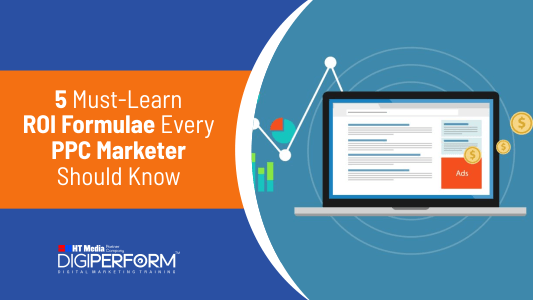How to Master 5 Essential ROI Formulae Every PPC Marketer Must Know
Pay-per-click (PPC) is a widely used internet advertising technique that digital marketing agencies leverage to drive targeted traffic to a business website. In this model, the client pays a publisher, like Google, for every ad click received. Agencies carefully design and deploy impactful PPC campaigns, often offering these services at affordable rates. However, despite the effectiveness of PPC, experts suggest that clients can waste up to 35% of their allocated ad budget. These losses can be mitigated by closely monitoring the return on investment (ROI).
Determine ROAS
The return on ad spend, or ROAS is not the same as ROI. The later calculates and compares the project expenditure with revenue gains. Ad spending assessment should not be dependent on the profit margins alone. The marketer also has to account for the client’s cost of doing business. Here ROAS is crucial, as it approaches PPC profits linearly, whereas the ROI is a multi-dimensional PPC cost evaluation.
Now, how do we determine this crucial metric called ROAS? You have to take into consideration the total conversion value and the total ad cost. Now, divide the former by the later, and you get the accurate ROAS. If you have a Google Ad account, then tick the all conversion value/cost option.
Let us look at an example to understand how this works.
- You spent US$ 20,000 on the ad campaign.
- It got about 500 leads, and you profited 50$ from 300 leads.
- The conversion value is 300 * 50 = 15000
- So ROAS is 15,000/20,000 is 2.5 or 250%
- So, every ad dollar gave a return of US$ 2.5
Set a break-even ROAS
ROAS is not sufficient as business retailers have to handle product costs too. So, even with a ROAS of 200%, the client can still be losing money. One can measure it by calculating the profit margins. So, break-even ROAS becomes vital.
But clients have different ways of calculating the profit margins. So, we have to first determine the profit margin and use it in formula 1/ profit margin to get a break-even figure. Let us take this airline ticket booking fares as an example:
- Say, the average revenue on the booked ticket is US$1600
- About 65% of it is commission, and 6% is the service cost.
- Now, 65% of 1600 + 6% of 1600 = 1040 + 96 = 1136
- So the profit is 1600 – 1136 = 464
- And the profit margin is 29% ( 464*100 / 1600)
- Now we get break-even value from 1/ .29 or 3.4 or 340% ROAS
- So, for every ad dollar, you have to make US$3.4
Caution: Any revenue of over 340% ROAS is linearly profitable. But this leads to short-term thinking, which affects customer loyalty, referral count, and subscription volumes.
Determine CPC forms
Form submission is a conversion action in the client’s PPC accounts. But they do not directly indicate profit or revenue. So, attributing a cost per conversion here is tricky as amounts vary drastically. A competent marketer will focus on knowing the true costs per conversion. So, one should assess the form of submission costs that earn a sale or deal.
First, calculate the average cost per conversion (form submission). Next, get the average form conversion rate (percentage of forms that lead to sales). Now divide the former by the later to get the CPC forms value. It helps in identifying areas of improvement that produce higher ROIs.
The average ad cost per conversion (airline ticket sale) is 37%, and 15% of forms close the sale, then CPC is 37/.15 or US$246.67. Now, the ROI is (US$464 – US$ 246.6) / 246.6 = 0.88. So on each dollar, US$0.88 is the return, or in other words, there is a 108% ROI.
Determine break-even CPA forms
We calculate break-even CPA to know maximum ad spending. For a 15% closing rate, US$37 conversion cost is profitable. But let us say the cost is now US$42. Yes, you can calculate the new CPC, but the break-even cost per 1 form account is more insightful. Multiply average profit with the form conversion rate. So 464 * 0.15 = US$69.6. So, you can pay up to this amount for one form submission to break-even.
Determine break-even CPA for long sales cycle
This formula is for long sales with multiple touchpoints. It can get complicated, so let us look at an example. A company sells a monthly subscription to cloud-based software.
- Average subscriber revenue is $3,287
- PPC ad sends traffic to a webinar promo page.
- 45% of webinar registrants attend.
- 15% sign up for cloud subscription
- Now, Break-Even CPA needs :
- Average profit per sale
- Webinar conversion rate (WCR) – it is the percentage of attendance among those who registered
- Sales conversion rate (SCR) – it is the percentage of attendees who ends up buying a subscription
- The formula is (WCR X SCR) x Average profit in a sale.
- So, (45% x 15% ) x $3,287 = $221.87
- The break-even CPA for a webinar registrant is $221.87.
- For example, of 500 webinar registrants, 225 attend, and 34 subscribe.
- The average customer profit is $3,287.
- So, 34 * $3,287 = $111,758 is break –even value.
It is not about knowing these formulae by heart. It is important to know how these formulae make sense and how to utilize them in your marketing campaigns to focus on profit from stage one.






